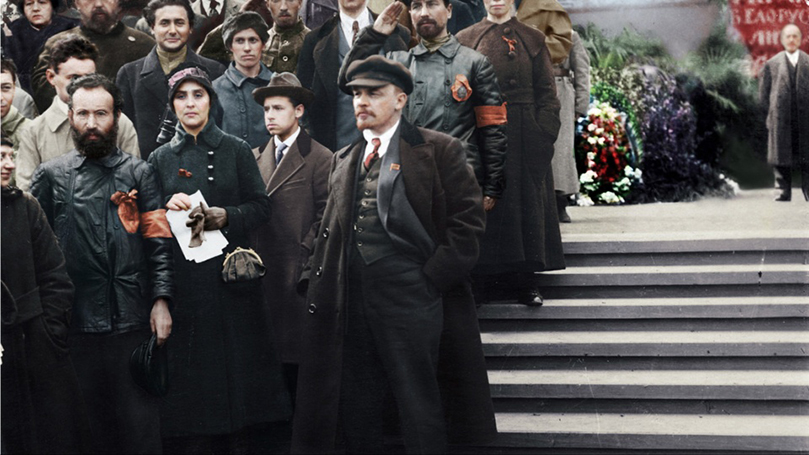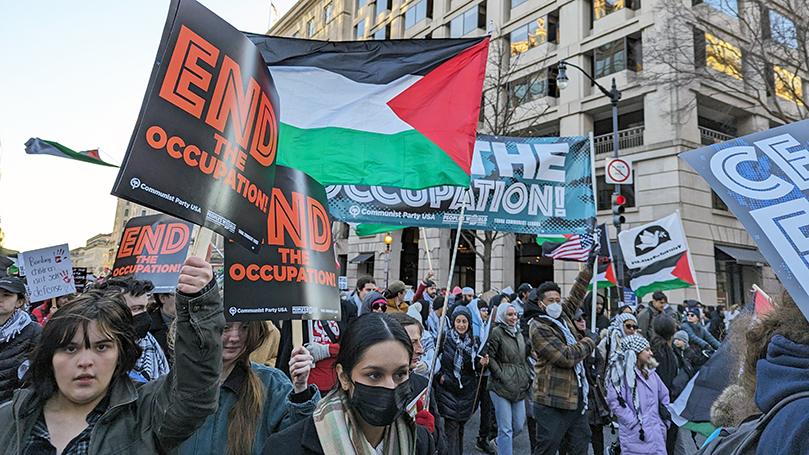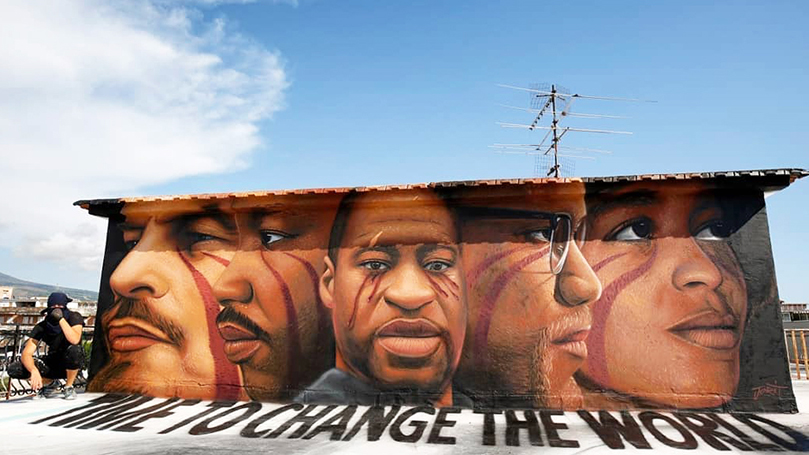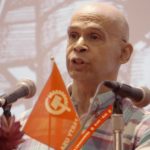
Lenin walks around the world. . .
The sun sets like a scar,
Between the darkness and the dawn,
There rises a red star.
–Langston Hughes
The world is a better place because of V. I. Lenin. An outstanding 20th-century working-class leader and revolutionary, he helped change history. The revolution in St. Petersburg, which Lenin helped lead in 1917, opened the door to a new era.
The impulse first set in motion by the October Revolution lives on, even 100 years after his death. The world revolutionary process continues to unfold a century later: at times by fits and starts, at others almost standing still, then explosively, rapidly, with all the force of a social hurricane.
This remains the epoch of the revolutionary transition from capitalism to socialism — setbacks, contractions, and reversals notwithstanding. As Lenin himself once observed, the socialist revolution is not a single act but a series of acts over an entire historical period.
Without October, the very concept of working-class rule, the idea that ordinary workers are “enough” — that they possess everything needed to create a new just world—would remain a distant dream. Without October, Asia might never have awakened, the chains of colonial rule binding Africa might never have been broken, and Europe might still lay claim to all of Latin America as its special province. Yes, the stirrings of anti-colonial, anti-racist, anti-imperialist struggle were set in motion — not necessarily causally, but, deliberately, willfully — across an oppressed and anguished planet.
The reverberations were no less felt in the coalfields, steel towns, and garment sweatshops of these United States. African American soldiers, leaving the battlefields of World War I and fleeing the lynch mobs of Made-in-America reaction, and Poles, Russians, Irish, Italians, and Jews, pouring through the gates of Ellis Island, all heard the resounding crash when the walls of the Winter Palace came tumbling down in Petrograd.
It was then that a self-described “socialist-of-the path” became, according to Paul Robeson, an advocate of “socialism-as-a-way-of-life.” W.E.B. DuBois, who later became Robeson’s close friend, declared after visiting Soviet Russia, “I may have been partially misled and misinformed, but if what I have seen is Bolshevism, I am a Bolshevik.”
Indeed, it was the restless genius of Lenin, the Bolshevik, whose theoretical imagination, strategic outlook, and tactical brilliance impressed the no-less-brilliant DuBois, whose African Roots of the War mirrored, if not anticipated, Lenin’s Imperialism on the sources of World War I.
Founder of a world movement
More than any other figure, Lenin helped birth the modern Communist movement.
The young Lenin early on grasped the scientific socialism developed by Engels and Marx, which he saw as a way to understand and change the world. At once a fierce defender and, at times, acerbic articulator (sometimes to a fault), of the Marxist worldview, Lenin managed to creatively add to and develop the Communist outlook.
Already, his Two Tactics, in embryonic form, stressed what came to be known as the “united front” concept, the absolute necessity of a broad front led by the working class to defeat reaction. Here, Lenin resolutely challenged the “left” posturing of those Marxists who feared an alliance with capitalists against a greater enemy, arguing again and again that the working class must lead the battle for democracy.
Addressing the unique circumstances of the revolutionary working-class movement in Russia, his What Is to Be Done? advanced the concept of a new type of political party, worker-led and directed, waging a many-sided struggle for dominance in the arenas of ideas, politics, and class struggle.
Following Marx and Engels’ thesis on the independent and leading role of the working class, Lenin’s concept was a new thing, a party led politically and ideologically by workers, that would lead the whole of society to a new form of civilization.
In What Is to Be Done? Lenin stresses — no, insists — on the party’s advocacy of socialism while fighting for reforms, arguing that without that, all struggles, trade union or no, would result in reforms alone. The achievement of socialism required, in his estimation, an extra element or ingredient, a Marxist “plus.”
But his concept of the party was not a thing frozen in time: The cadre concept advanced for uniquely Russian circumstances was later replaced by the “mass party” that would seek working-class majority support for its aims.

The concept of the working-class press as a collective organizer, mobilizer, and publicist deepened with the application of its use as a central organizing tool. In other words, the press had to be built around the party, and the party itself was built around the press, a notion particularly relevant with today’s internet, social media, social networks, and big data.
Living doctrine
Marxism, for Lenin, was a living doctrine whose various sides modulate and shift according to the conditions of the workers’ class struggle, with now one, then another “side” coming to the fore. He took issue at once with one-sided, narrow, and sectarian approaches while also castigating those who would “turn Marx into an ordinary liberal” with the claim that the socialist goal was utter utopianism.
Understanding that Marxism as a scientific outlook was by its very nature partisan, capable of conception only polemically, Lenin’s theoretical contributions were always couched in its defense. He glanced with suspicion, if not contempt, at those who sought to “develop” Marx with long-discredited “flexible” concepts in “new” clothing. At the same time, fearful of dogmatism and being a student of science, he read and studied voraciously, testing his materialist outlook against new discoveries, discarding what proved wrong, and incorporating the new.
Lenin was not wedded to any particular form of struggle. Everything depended on a concrete analysis of a concrete situation. In the summer of 1917, he wrestled over and over with the possibility of a peaceful transition to state power. The tumultuous “July Days,” though, changed his mind, and August found him hiding in a barn writing The State and Revolution.
His Imperialism, written a year earlier, theorized a new stage of capitalism dominated by the big banks, and along with it the theory of the “weakest link” and the possibility of a breakaway from the capitalist world system. While tracing imperialism’s economic contours, characterized by the export of capital, his attention turned invariably to issues of democracy.
Defining imperialism politically, as “reaction all down the line,” he pointed to its financial, production, and trade cycles and their inevitable impacts, pulling peoples and nations together and forcing them apart, over and again, imposing both unity and separation, an objective process in which opposites are perpetually in motion. He asks provocatively, “Between the two which is primary?” “Unity,” was his clear and unequivocal answer.
The classic works of V.I. Lenin are available from International Publishers.
Lenin wrote extensively on colonialism and championed the rights of oppressed nations and peoples to self-determination. National oppression was for him, at its very essence, an issue of democracy, the “right” of a people to determine their own destiny. The working-class movement must put this issue front and center, he said: “Whoever does not recognize and champion the equality of nations and languages, and does not fight against all national oppression or inequality, is not a Marxist; he is not even a democrat.”
A democrat
Indeed, the content of democracy was a central concern of Lenin, who viewed its destination as invariably shaped by the contours of the road traveled. He wrote, “All ‘democracy’ consists in the proclamation and realization of ‘rights’ which under capitalism are realizable only to a very small degree and only relatively. But without the proclamation of these rights, without a struggle to introduce them now, immediately, without training the masses in the spirit of this struggle, socialism is impossible.”
Needless to say, the founding of the new working-class state and the elaboration of the laws of transition from capitalism to socialism are among Lenin’s most important if not his signal contributions.
The necessity of working-class leadership, the emergence of a new form of state power, the Soviets, the relationship between the party and the state, the content of the economy — all of this and more seized his attention.
Here again, when confronted with the backwardness of the Russian economy, “war communism,” and the need to switch economic gears, Lenin held firm not to dogma but to science and proposed the New Economic Policy, premised on working-class power in government and “state capitalism” in the economy. The idea of peaceful co-existence between different social systems was his.
Toward the end of his brief but eventful life, thinking through strategies for the newly-founded communist parties was of major concern. Here, Lenin contended with political mistakes of both left and right. In the Communist International, stress was placed on the necessity of winning over the majority of the working class as opposed to attempts at seizing power by small disciplined minorities.

It was in these debates that the united front concept was placed before the communist parties as a strategic concept while rejecting notions like Trotsky’s “permanent revolution” or Bela Kun’s “theory of offensive.” On this topic, Lenin’s “Left-Wing” Communism remains the most relevant of texts.
The life work of this Soviet Communist leader, along with his successes and failures, will be studied for some time to come. Like any life, it was not without error. Chief among them may have been Lenin’s polemical style, the impatient handling of differences, and the name-calling that infected the ideological and political struggle of the period.
With respect to the United States, the posing of the African American population as a nation was an error, as was the application of the labor aristocracy thesis as the sole explanation for the slow and hesitant growth of class and socialist consciousness — an underestimation of the influence of racism and what DuBois termed the psychological “wage of whiteness.”
Faith in the working class
But these issues, while important, pale somewhat in relation to the main challenge to Lenin’s legacy: the idea, following Plekhanov, that the Russian Revolution was premature and incapable of holding its own. It’s true that the leaders of the Russian Revolution themselves held definite trepidations regarding possible outcomes, hoping for a revolution in the West to come to the aid of the struggling young Soviet republic. In fact, Lenin bet on it. But the uprising in Europe failed to materialize.
Yet, despite this miscalculation, the revolution survived, albeit, at tremendous costs. Still, for 74 years, the Soviet Union attempted a model of socialism that made many advances, providing invaluable lessons. And its collapse was not inevitable.
Lending credence to this view are the experiences of Cuba, China, and Vietnam, nations that have found novel paths for pursuing the socialist goal premised on working-class leadership of the state. They may not have arrived quite yet, but the quest is ongoing and is helping reshape the planet.
The world today in many respects is quite different from the one Lenin departed almost a century ago. Climate change, global pandemics, changes in the very composition of the working class, growing right-wing power, artificial intelligence, social networks, and 24-hour news streams all impact the very forms and conditions of struggle.
The struggle for democracy, always at the very center of Lenin’s understanding of class struggle, has become even more acute. At stake here is the need to reject narrow concepts of working-class power: forced marches, administrative shortcuts, and short-sighted attempts to control information flows. The means of achieving, to say nothing of shaping, working-class rule will inevitably determine its end. This includes models of leadership, an insistence on collectivity, and regular replenishing of collective bodies.
If ever working-class majorities needed to be won to the socialist cause, is it not today? Must not education, culture, debate — in other words, the battle of ideas — assume an equal place with other forms of struggle? Should not a critique be made with respect to the very choice of weapons, making the weapons of choice strikes, occupations, boycotts, mass campaigns, and, yes, the ballot?
Late-stage monopoly capitalism is indeed “reaction all down the line,” as borne out by the rise (and revival) of global fascism, with all of its racism, sexism, and homophobia, today spurred on, not so much by the need to crush the imminent rise of a socialist power, as by transnational capital’s increasing inability to maintain the rate of profit and resolve its internal contradictions.
National hatreds, too, are prisons that hold people’s minds captive but must be broken. This is as true today as it was 100 years ago. And fighting for peace — in Gaza, in Ukraine, in Yemen, and everywhere — is just as urgent for us now as it was for the Bolsheviks in the early years of the last century.
The answer to it all is democracy, democracy, and more democracy. But not just any democracy — class democracy, advanced democracy giving all power to the workers and the people.
Images: Lenin at a parade on Red Square on May 25, 1919, colorizing by Klimbim; CPUSA at the January 13 March on Washington for Gaza by People’s World (CC BY-NC 2.0 DEED); Time to change the world mural by Jorit (Instagram)


 Join Now
Join Now